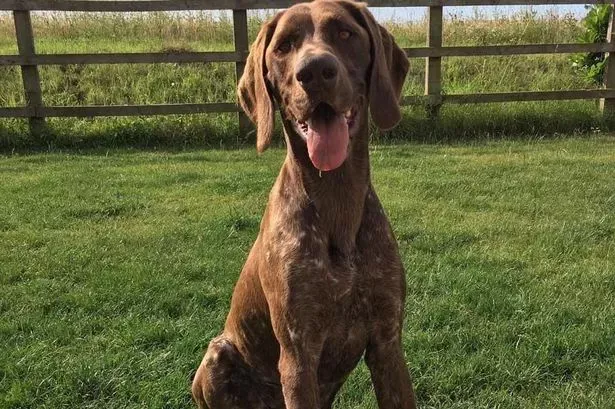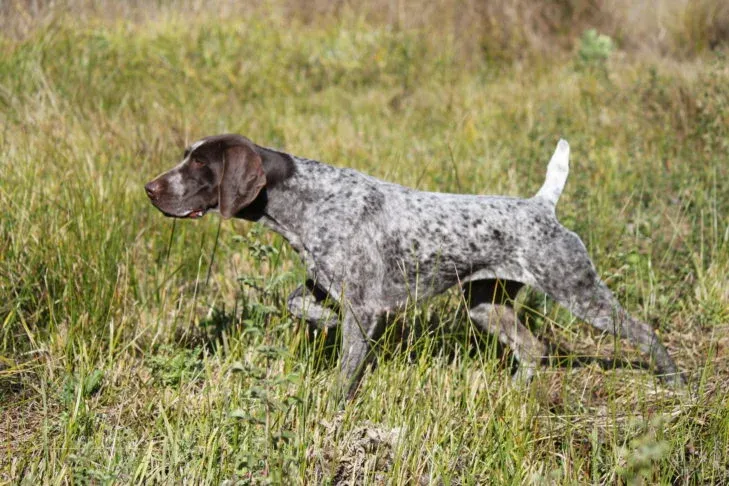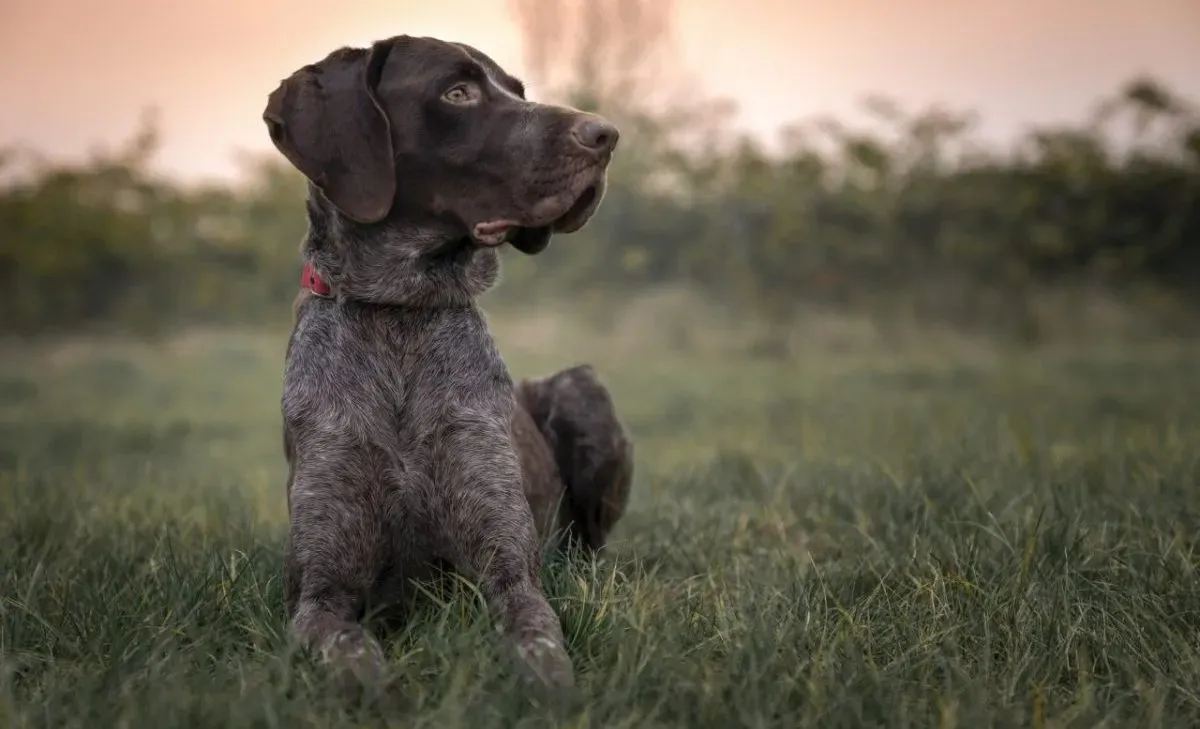German Shorthaired Pointers are popular and versatile hunting dogs known for their intelligence, athleticism, and friendly nature.
This article will provide valuable information about the German Shorthaired Pointer, covering various aspects such as size, exercise needs, lifespan, intelligence, coat colors and grooming, temperament and compatibility, breed history, and the controversy surrounding tail docking.
This comprehensive article will provide insights into the German Shorthaired Pointer breed, allowing readers to understand and appreciate the qualities, care needs, and historical significance of these remarkable dogs.
Key takeaway:
- Size and Physical Characteristics: The German Shorthaired Pointer is an athletic breed, with an average size that ranges from 21 to 25 inches at the shoulder and 45 to 70 pounds in weight. They have a short coat that is dense and water-repellent.
- Exercise and Activity Needs: The German Shorthaired Pointer is a high-energy breed that requires a significant amount of exercise. They thrive in active environments and enjoy activities such as running, swimming, and participating in dog sports.
- Intelligence and Trainability: German Shorthaired Pointers are highly intelligent and trainable. They have a strong desire to please their owners and excel in activities such as obedience training, agility, and hunting. Consistent and positive training methods are recommended.
Size and Physical Characteristics
Size and physical characteristics are important aspects of German Shorthaired Pointers. These dogs are known for their:
- Medium to large size, ranging from 21 to 25 inches tall at the shoulder
- Lean and muscular build, with a strong and agile body
- Short, dense coat that is waterproof and protects them in various weather conditions
- Predominantly liver or liver and white coloration
What is the Average Size of a German Shorthaired Pointer?
The average size of a German Shorthaired Pointer can range from 21 to 25 inches at the shoulder for males and 19 to 23 inches for females. In terms of weight, they typically weigh between 55 and 70 pounds. It is important to note that these measurements may slightly differ based on individual genetics and overall health.

What are the Physical Characteristics of a German Shorthaired Pointer?
The physical characteristics of a German Shorthaired Pointer include a muscular body, medium to large size, and a short coat that is dense and water-resistant. They have a sleek and athletic appearance with a well-defined head, expressive eyes, and floppy ears. These dogs are known for their agility, speed, and endurance.
Fun Fact: German Shorthaired Pointers are excellent swimmers due to their webbed feet.
German Shorthaired Pointers possess physical traits that include a robust physique, moderate to considerable dimensions, as well as a compact and water-resistant coat. They exhibit a streamlined and athletic look characterized by a clearly outlined head, eyes that convey their emotions, and droopy ears. These canines are admired for their agility, swiftness, and stamina. Notably, German Shorthaired Pointers excel in swimming thanks to their webbed feet.

Exercise and Activity Needs
German Shorthaired Pointers have high exercise and activity needs, making them suitable for active individuals or families.
- Provide daily exercise through activities like running, hiking, or playing fetch. This will help meet their exercise and activity needs.
- Mental stimulation through puzzle toys or training sessions is also important to fulfill their exercise and activity needs.
- Engage in activities that tap into their natural hunting and retrieving instincts, such as nose work or agility training. These activities will satisfy their exercise and activity needs.
To ensure a happy and healthy German Shorthaired Pointer, it is important to meet their exercise and activity needs on a regular basis.
How Much Exercise Does a German Shorthaired Pointer Need?
How Much Exercise Does a German Shorthaired Pointer Need? A German Shorthaired Pointer requires a significant amount of exercise to maintain their physical and mental well-being. Generally, they need:
- 1-2 hours of vigorous exercise daily to burn off energy and prevent behavioral issues
- Activities like running, swimming, and playing fetch
- Engagement in mentally stimulating exercises such as obedience training, puzzle toys, and scent work
What Activities are Suitable for a German Shorthaired Pointer?
- German Shorthaired Pointers excel in outdoor activities such as hiking, running, and swimming.
- Due to their athleticism and high energy, they make excellent candidates for agility training courses and competitions.
- These dogs love to retrieve objects, so playing fetch is a great way to keep them entertained.
- Engaging in obedience training can provide mental stimulation and discipline for highly trainable German Shorthaired Pointers.
- With their strong sense of smell, German Shorthaired Pointers are well-suited for tracking trails or participating in scent work.
- Originally bred as hunting dogs, German Shorthaired Pointers have a natural inclination for bird hunting or field trials.

German Shorthaired Pointers have a rich history as versatile hunting companions. They were originally developed in Germany in the 19th century to be all-purpose gun dogs, capable of pointing, retrieving, and tracking game. Today, they continue to showcase their hunting abilities in various activities and competitions worldwide.
Lifespan and Health
The lifespan and health of German Shorthaired Pointers depend on various factors. Lifespan and health are crucial for these dogs. On average, they live for 12-14 years. To ensure their good health, regular exercise, a balanced diet, and routine veterinary check-ups are essential. Taking care of their lifespan and health requires regular grooming and proper dental care. Additionally, it is important to monitor breed-specific health issues like hip dysplasia. When considering to adopt, it is recommended to choose from a reputable breeder who prioritizes the lifespan and health of their dogs. Providing a loving and stimulating environment will contribute to the overall lifespan and health of your furry friend.
What is the Average Lifespan of a German Shorthaired Pointer?
The average lifespan of a German Shorthaired Pointer is around 12 to 14 years. What is the Average Lifespan of a German Shorthaired Pointer? While individual lifespan can vary depending on factors like genetics, diet, and overall health care, proper exercise, a balanced diet, and regular veterinary check-ups can help ensure a longer and healthier life for your German Shorthaired Pointer. Providing a loving and stimulating environment can contribute to their overall well-being.
Are There Any Breed-specific Health Concerns?
- Are There Any Breed-specific Health Concerns?: German Shorthaired Pointers are prone to Hip Dysplasia, which can cause pain and mobility issues.
- Bloat: This breed is also susceptible to Gastric Dilatation-Volvulus, a serious condition where the stomach fills with air and twists. Immediate veterinary intervention is necessary.
- Eye Conditions: Some German Shorthaired Pointers may develop inherited eye diseases such as cataracts or progressive retinal atrophy.
- Ear Infections: With their floppy ears, German Shorthaired Pointers can be prone to ear infections. Regular cleaning and maintenance are crucial.
Intelligence and Trainability
- The German Shorthaired Pointer is renowned for its intelligence and trainability.
- They excel in a range of dog sports, including obedience, agility, and tracking.
- This breed is quick to learn and eager to please its owner, which makes training sessions enjoyable.
- When teaching new commands, consistency and positive reinforcement methods prove to be the most effective.
How Intelligent is a German Shorthaired Pointer?
German Shorthaired Pointers are known for their intelligence, making them highly adaptable to a range of tasks such as hunting, agility, and obedience training. Their problem-solving abilities and quick learning skills are evident, showcasing just how intelligent they really are. With proper training and mental stimulation, German Shorthaired Pointers can excel in various activities, highlighting their versatility and intelligence.
Is a German Shorthaired Pointer Easily Trainable?
Yes, a German Shorthaired Pointer is easily trainable. Their intelligence and eagerness to please make them highly responsive to training. By using consistent and positive reinforcement methods, commands and obedience tasks can be quickly learned by German Shorthaired Pointers. Their trainability is a characteristic that makes them popular as working dogs in various fields such as hunting and search and rescue.

Coat Colors and Grooming
- The German Shorthaired Pointer is known for its variety of coat colors, which includes liver, black, and liver and white.
- When it comes to grooming, this breed is relatively low maintenance, simply requiring regular brushing to remove loose hair and occasional bathing.
- To maintain their overall health, it is important to regularly clean the ears to prevent infections, and nails should be trimmed as needed.
- It's worth noting that the different coat colors can impact their grooming needs, as lighter-colored dogs may show dirt more easily.
What are the Common Coat Colors of a German Shorthaired Pointer?
- Common coat colors of a German Shorthaired Pointer include liver, liver and white, black, black and white, and roan.
- Liver: The coat is predominantly brown with patches or spots of a slightly lighter shade.
- Black: The coat is solid black without any other color markings.
- Liver and white: The coat is a combination of brown and white, with larger areas of brown and smaller patches of white.
- Black and white: The coat is a combination of black and white, with larger areas of black and smaller patches of white.
- Roan: This coat color consists of a mixture of white hairs and colored hairs, creating a speckled or mottled appearance.
The German Shorthaired Pointer offers a range of coat colors, including liver, liver and white, black, black and white, and roan. These colors provide diversity and unique aesthetics for potential owners to choose from.
What is the Grooming Needs for a German Shorthaired Pointer?
The grooming needs for a German Shorthaired Pointer are relatively low-maintenance. What is the Grooming Needs for a German Shorthaired Pointer? Their short coats require regular brushing to keep them clean and remove any loose fur. They only need occasional baths, usually when they get dirty from outdoor activities. Keeping their ears clean and nails trimmed is also important for their overall grooming. Remember to give them lots of love and attention during their grooming routine to strengthen the bond between you and your furry friend.
Temperament and Compatibility
The German Shorthaired Pointer is well-known for its friendly and adaptable temperament, which contributes to its compatibility with various lifestyles. When evaluating temperament and compatibility, it is important to consider the following factors:
- Activity Level: This energetic breed thrives in active households and requires ample exercise and mental stimulation.
- Socialization: Early socialization is of utmost importance in ensuring a well-rounded and amicable temperament.
- Family Compatibility: German Shorthaired Pointers generally get along well with children and other pets, although they may exhibit a strong prey drive.
- Training Needs: With their high intelligence and eagerness to please, they are highly trainable. However, consistent and patient training methods are necessary.
Is a German Shorthaired Pointer a Good Family Dog?
- Is a German Shorthaired Pointer a Good Family Dog? German Shorthaired Pointers are excellent family dogs due to their affectionate and loyal nature.
- They are known to be patient and gentle with children, making them a great addition to a family with kids.
- They thrive in an active family environment and enjoy participating in various activities like hiking, running, and playing fetch.
- Their intelligence and trainability also make them suitable for obedience training and other mental stimulation exercises.
Fun Fact: German Shorthaired Pointers have a strong sense of smell and are often used as hunting dogs for tracking game.
Are German Shorthaired Pointers Good with Cats?
German Shorthaired Pointers can be good with cats if properly socialized from a young age. Their strong hunting instincts may make them prone to chasing smaller animals. It's important to introduce them to cats slowly and supervise their interactions. Providing separate spaces and positive reinforcement can help foster a harmonious relationship.
Breed History and Purpose
The German Shorthaired Pointer has a breed history and purpose that is both rich and distinct. Originally developed in Germany during the 19th century, these dogs were specifically bred for their versatility in hunting. With their agility, intelligence, and exceptional sense of smell, they excel in a wide range of hunting activities which include tracking and retrieving. To ensure their happiness and contentment, it is important to provide them with both mental and physical stimulation.
Pro-tip: Engage them in activities that challenge their instincts and abilities.

What is the History and Origin of the German Shorthaired Pointer?
The History and Origin of the German Shorthaired Pointer is quite fascinating. It dates back to the 19th century and was developed in Germany. By crossing breeds like the Spanish Pointer and the English Pointer, this breed was created. Known for its versatility as a hunting dog, the German Shorthaired Pointer possesses remarkable scenting abilities, agility, and endurance. It can be traced back to its roots, specifically the German Bird Dog, from which it was refined to become the German Shorthaired Pointer breed.
What is the Pointing Ability of a German Shorthaired Pointer?
The pointing ability of a German Shorthaired Pointer is exceptional. What is the Pointing Ability of a German Shorthaired Pointer? They have a natural instinct for locating and pointing game birds, making them excellent hunting companions. Their sharp sense of smell combined with their intense focus and precise pointing posture make them highly effective in the field. Consider getting a German Shorthaired Pointer if you are an avid hunter or enjoy outdoor activities with a canine partner.
Tail Docking Controversy
The practice of tail docking, which involves removing part of a German Shorthaired Pointer's tail, has long been a subject of controversy. The issue of whether it is necessary for breed standards or unnecessary and inhumane has sparked heated debates among advocates and opponents. Moreover, varying views on legislation and public opinion concerning tail docking can be observed across different countries and regions.
Some Facts About German Shorthaired Pointers:
- ✅ The German Shorthaired Pointer was developed in Germany in the 19th century as a versatile hunting dog and friendly companion.
- ✅ They are known for their ability to hunt, point, and retrieve various types of prey.
- ✅ German Shorthaired Pointers have a strong prey drive and need to be kept in a well-secured area.
- ✅ They require ample physical activity, including running, swimming, and long walks, due to their endless energy.
- ✅ Training classes are recommended for German Shorthaired Pointers to prevent destructive behavior and harness their energy.

Frequently Asked Questions
1. What are the characteristics of a German Shorthaired Pointer?
A German Shorthaired Pointer is a medium to large-sized breed with an athletic build and a short, flat coat. They have various colors and patterns, with brown eyes and an outgoing nature. They are versatile hunting dogs known for their exceptional stamina, keen sense of smell, and instinct for hunting and pointing game.
2. Are German Shorthaired Pointers suitable as family pets?
Yes, German Shorthaired Pointers make great family dogs. They are affectionate, loyal, and known for forming strong bonds with their families. However, they may be too rambunctious for small children and require proper socialization.
3. How much physical activity do German Shorthaired Pointers need?
German Shorthaired Pointers have endless energy and require ample physical activity. They excel in various dog sports and activities, such as agility competitions, field events, and dock diving. They need regular exercise, including running, swimming, and long walks.
4. How should German Shorthaired Pointers be trained?
Training classes are recommended for German Shorthaired Pointers to prevent destructive tendencies and harness their energy. They are highly trainable and eager to please their owners. Positive training methods work best with this breed.
5. Do German Shorthaired Pointers need a well-secured area?
Yes, due to their strong prey drive, German Shorthaired Pointers should be kept in a well-secured area to prevent them from chasing after prey. They have a versatile hunting instinct and may scale fences if not properly contained.
6. What is the lifespan of a German Shorthaired Pointer?
The average lifespan of a German Shorthaired Pointer is 12-14 years. However, they may be prone to some health issues such as hip dysplasia, elbow dysplasia, eye problems, and bloat. Regular vet check-ups and a healthy lifestyle can help ensure their well-being.




